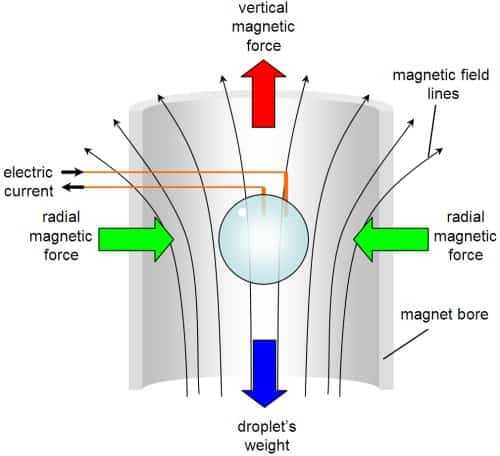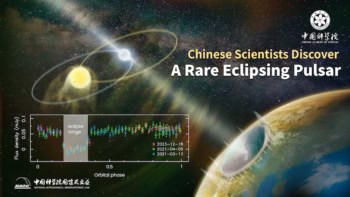
Water droplets with two or three lobes have been made by physicists in the UK, who levitated and spun the liquid using a giant magnet. The experiment could help physicists gain a better understanding of rapidly-spinning nuclei, Kuiper belt objects and even black holes.
Surface tension is what makes a free-floating droplet of liquid form a spherical shape. However, when rotated the same drop will become distorted as centrifugal forces tend to pull it apart — resulting in a bulge along the equator and flattening at the poles.
The drop will become more and more oblate as its speed of rotation increases, until it reaches a point where the competition between surface tension and centrifugal forces causes its axially-symmetric shape to become unstable and it transforms into a two-lobed, or peanut-shaped, object. Further increases in rotation speed should then add a third lobe, and, beyond that, four lobes. Eventually, the droplet ought to become doughnut shaped.
More than a century ago the Belgian physicist Joseph-Antoine-Ferdinand Plateau tried to simulate fast-spinning planets and stars using spinning droplets. He reasoned that the cohesive force of gravity in such massive objects might act like the surface tension of a free-floating liquid droplet. He placed a droplet of olive oil in a mixture of water and alcohol with exactly the same density as the oil, thereby suspending the droplet. Then, by rotating the droplet to increasing angular velocities using a spinning shaft, he observed that the drop became ellipsoid and then twin-lobed.
Our experiment in the lab is on a human scale, you can see the droplet with the naked eye and you can poke it Richard Hill, Nottingham University
Although elegant, Plateau’s experiment has proven difficult to compare with theory because of the effects of drag by the surrounding liquid. More recently, physicists have tried to avoid this problem by levitating droplets in air using sound waves — creating three-lobed droplets that were very unstable. Experiments carried out in orbiting spacecraft, on the other hand, have succeeded in producing two-lobed but not three-lobed droplets.
Diamagnetic levitation
Now, Richard Hill and Laurence Eaves of Nottingham University have generated stable three-lobed water droplets here on Earth using diamagnetic levitation. They placed droplets inside the vertical bore of a 16.5 Tesla superconducting magnet with a field that decreases rapidly from the centre of the superconducting solenoid.
Their technique exploits the fact that water is diamagnetic, which means that when placed in a powerful and spatially-varying magnetic field droplets will be repelled from the high magnetic field generated by the solenoid, which in this case causes them to levitate. The droplets also had a pair of parallel, thin electrodes inserted into them in such a way that the magnetic force on the current passing between the electrodes exerted a torque on the droplets, which set them spinning (Phys. Rev. Lett. 101 234501).
The physicists watched as the droplets becoming ellipsoid and then peanut shaped. They were also able to use one of the electrodes to set up a travelling wave in motion around droplets that had a certain size and surface tension. This wave hindered the formation of two-lobed structures but acts to stabilize a three-lobed droplet, which would otherwise collapse almost instantaneously into the two-lobed variety.
Hill admits he doesn’t fully understand how the wave has this stabilizing effect, but points out that the rotation speed at which he initiated two- and three-lobed structures very closely matched theoretical predictions. He believes that the research could lead to breakthroughs in other areas of physics, noting that nuclear physicists used the liquid-drop model to describe the nucleus and that astrophysicists have recently observed rapidly spinning objects in the Kuiper belt that are likely to be ellipsoidal. “Our experiment in the lab is on a human scale, you can see the droplet with the naked eye and you can poke it,” he told physicsworld.com, adding “But we can use it to gain new insights into exotic objects on much smaller or larger scales.”
Three-lobed black hole?
In particular, this new research might prove particularly well suited to studying black holes, since cosmologists believe that a black hole’s event horizon acts as if it had a surface tension. Vitor Cardoso, a physicist at the Technical University of Lisbon in Portugal and the University of Mississippi in the US says that while black holes are not believed to form multi-lobed structures in our normal four dimensions of space time they may do so in higher dimensions. “People working in string theory and general relativity are looking to see if somewhere in their equations there is a solution describing a two- or three-lobed black hole,” he says.




